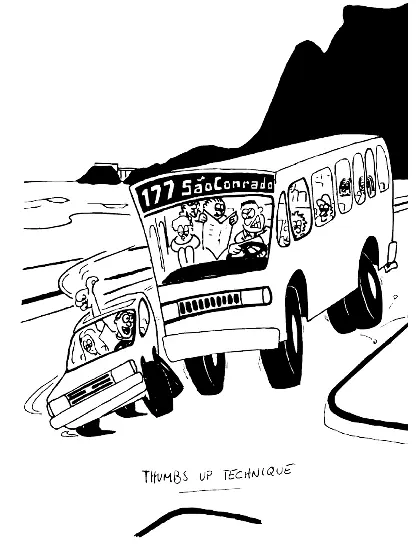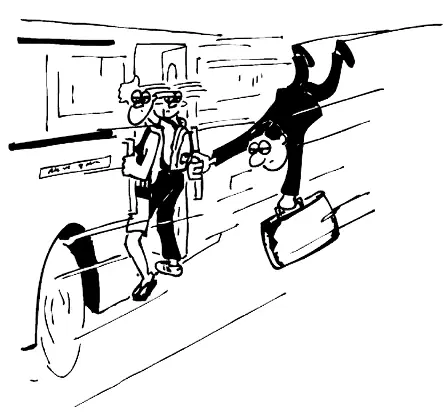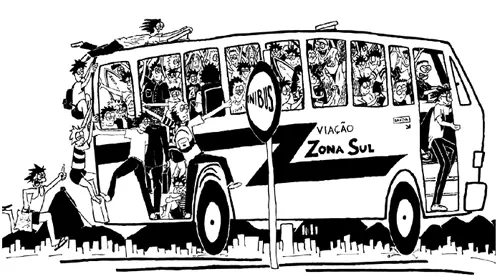If you were a taxi driver, it would be hard on the neck while driving to turn around and carry on a conversation with the passenger in the back seat;
With all the time spent turning off the alarm systems every time you get behind the wheel, buckling up as well would mean you’d always be late;
It is just too hot. (Besides, it tickles the neck.)
So as not to get a multa[’mool tah] (fine), Cariocas will always wear seat belts when driving on a federal highway, even diehard taxi drivers.
Common courtesies in traffic:In Rio, it has been said that the shortest interval of time is between when the light turns green and the driver behind you honks. Since traffic lights are often hidden behind trees or strategically placed overhead at intersections, honking to let the driver in front of you know the light has changed is a common courtesy in traffic. Of course, it is always wise to double check before Stepping on the gas. That honking motorist behind you might be just trying to catch the attention of a passing gataor gatão.
If the driver in front of you puts his hand out the window and motions in an open-and-close fashion, you can be sure he is not suggesting that you are talking too much. He is simply letting you know that you forgot to turn off your headlights after passing through a tunnel.
It is wise to always keep an eye on your rearview mirror. In the blink of an eye you will find a car, one that had previously been nowhere in sight, just centimeters from your rear bumper flashing his brights. This is the Carioca way of letting you know that you are expected to move over and let him pass. If you don’t, he will just squeeze in next to you anyway and pass into the seemingly nonexistent space in front of you.
Although there are several acceptable Carioca procedures for parking your car in Rio, there is only one way a Carioca on wheels will pass a slower car when going through any of Rio’s numerous tunnels.
The Correct Procedure For Passing in a Tunnel
Step 1. Tailgate the slower car in front of you by maintaining a maximum distance of five inches.
Step 2. Continuously blink your high beams (at least five times). Step 3. Down shift one gear (fourth to third).
Step 4. Move aggressively to the right lane without using your blinker.
Step 5. Accelerate completely, pé na tábua(pedal to the metal)!
Step 6. As you are passing the slower car, signal your disgust to the other driver by tossing your hand in the air in his direction, shaking your head in disbelief, and uttering the appropriate language while shifting back into fourth.
Step 7. Once the pass is completed, move aggressively back to the left lane without using your blinker.
Step 8. Be sure not to leave more than three feet between your back bumper and the car you have just passed. If you leave more, another car will squeeze in behind your car and tailgate YOU.
When it seems like nobody is going to let you through when you’re attempting to enter a speed lane, move out of a parking spot, or make a turn, use the «thumbs-up technique.» Simply put your hand out of the car window in a thumb upward motion, smile, and go for it. The «thumbs-up technique» makes any maneuver acceptable.
A word of caution: Do not be tempted to use the traditional thumb and index finger OK sign when maneuvering through Rio’s traffic. Since the OK sign has a very different connotation in this country, w;hen using it you might find yourself in a not-OK situation.

If you are not sure about trying your hand at the wheel in Rio, try just going for the ride. By taxi you will live all the excitement of the traffic without having to drive. Best of all, if by any chance you do get in an accident, it won’t be your car, and it won’t be your fault either!
Cabs are painted yellow with a blue stripe. You will see small cabs and big cabs. They all cost the same, big or small, AC or no AC. So if you are not in a hurry, pick out a decent-looking, bigger cab, preferably one with four doors — just in case you need to make a speedy exit.
To stop a cab, wave frivolously, but don’t stand on the road. Due to the taxi driver’s enthusiasm, he might run you over! Then get in and tell the driver where you want to go.
Never criticize a taxi driver’s driving ability, even if he seems to be completely out of control. Carioca taxi drivers get very offended since they consider themselves the only good drivers on the road.

Talk to the driver about the weather or the traffic. Create a friendly atmosphere, and attempt not to look ignorant — or like a tourist. If you look like you don’t know what you’re doing, the numbers on the meter will be left aside, and he will feel justified to create a «gringo surcharge.» (In other words, rip you off!) Cariocas will only take taxicabs in emergencies. A real Carioca will either drive, take the bus or hail a van.
If his car has been stolen, is in the shop, or if he just doesn’t have one, the Carioca will look to the public transportation system as a convenient, dependable means of getting around. Consequently, when riding the bus in Rio, you’ll have the opportunity to encounter Cariocas from all walks of life: from the executive who commutes on the bus to avoid dealing with the bother of downtown parking, to the Dragão Chinês (Chinese Dragon Popsicle) salesman who gets on the bus in mid-summer with a Styrofoam container filled with Popsicles, sells them all to the passengers, and then, before jumping off, announces to his captive audience that he loves having been born a Carioca because he gets to make a living without having to really work.
Riding the bus gives you a different perspective on the traffic, plus plenty of room to admire the view. You’ll feel a lot safer riding the bus, but it is a fake sense of security since bus drivers race and squeeze each other just like everybody else does. Only by trying it can you experience and believe the speed and G-forces that can be achieved while riding on a public bus.


Buses will only stop at their bus stops, which are clearly marked by small wooden signs with numbers on them, either attached to poles by the road or hanging from nearby trees. The easiest way to spot a bus stop is to look for a gathering of people by the right side of the street, and there should be one every other block or so. Note: A real Carioca can manage to stop a bus away from the bus stop.
When picking up a passenger, some bus drivers tend to avoid coming to a complete stop, thus causing passengers to grab on and hop in while the bus is in motion. Since this requires running, jumping, and pulling, being in good athletic condition is strongly recommended before attempting your first bus ride around Rio.
It comes with the territory that when riding a bus in Rio you might have the opportunity to experience one of the city’s most common inconveniences — you might be mugged. Unfortunately, that is a risk you take when riding a bus in any major city. And luckily, in Rio, it’s really not that bad since muggers are only out for the loot (the cameras and expensive looking jewelry that could so easily have been left back at the hotel or your apartment), and they are really not interested in you. But if being on the wrong end of a pickpocket or thief on a bus isn’t your idea of a good time, it can definitely be avoided by not having any of the following in your possession while riding a local bus:
Читать дальше
















